Rob Inns delivers part one of his 'River Carp Fishing Tips' series...
One element of carp fishing I have found myself increasingly involved in in recent years is river carp fishing. I think what attracts me to river carp is their wild and nomadic life style. But their ability to travel where ever they wish, coupled with the fact that most rivers do not benefit from stocking programs other than that put in place by mother nature herself, can make catching them tricky at times. I hope this piece can give you some tips that I have learned and implemented personally on rivers not just in the UK but also in France and Spain.
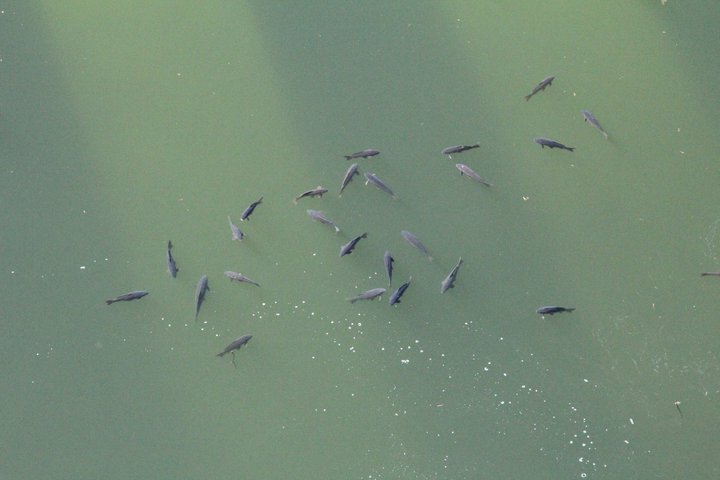
- A group of carp around the Riba Roja dam
Features
So how do you go about finding a relatively low stock of fish that have miles of river system to explore at will? The trick is to find yourself some kind of feature; these can be anything as large and obvious as an island or a bridge, to something as subtle as a bush overhanging into the water. What you are looking for is something that makes your swim different to the miles of river either side of it, something that may stop the course of drifting food creating natural larders on the river bed.

One extreme example I have come across in my travels of a big man made feature becoming a natural holding area for river carp is the massive hydro damn at Riba Roja on Spain’s river Ebro. Small fish are sucked into the turbines at these hydro damns where they are shredded and passed back out the other side, carp gather here in huge numbers to feast on this free meal. In the summer when the water is crystal clear it is an amazing sight to see so many big carp in one place, especially on a river.
But as I mentioned not all features are quite so in your face, one of my favourite spots on the river Thames is far more subtle, in fact there is no surface feature visible at all. This spot is situated in a very popular built up area where people use a set of steps down to the river to feed the large number of swans that reside in the area, it is this act that creates the feature. When the swans feast on loaf after loaf of bread they inevitably drop scraps that sink to the bottom. As night time falls and the birds move off to their nests the carp move in to feast on these scraps.
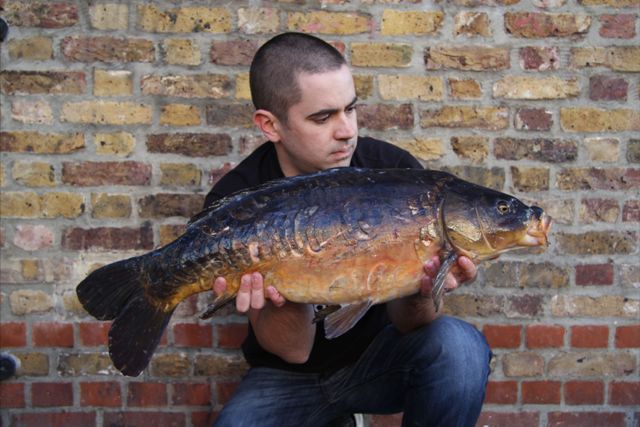
- Scaley old Thames carp caught from the swan step swim.
This on going process has created a permanent 3m² clear gravel area at the bottom of these steps. This works as a perfect underwater fish holding feature and one that I have capitalized on with short early morning summer sessions (summer being when most of the bird feeding takes place) on many occasions, catching some stunning scaly old river carp.
Bait and rigs
Once you have found your spot the next step is to decide which bait to use and how to present it (which rig to use). As with still waters the best bait and rig really does vary depending on which water you are fishing and also sometimes which swim you are fishing, so all I can tell you here is what I have found on the rivers that I have fished myself.
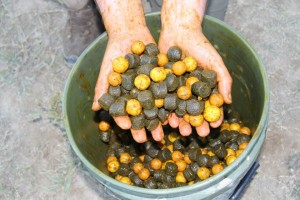
- My Ebro mix of yellow boilies and pellet.
On my trips to the Ebro I have found two baits that really seem to out fish the others I have tried, the first being yellow Boilie’s and lots of them. It didn’t seem to matter what flavour they were as long as they were yellow, and believe me when I tell you we really have tried every imaginable colour. I don’t know the relevance of the yellow and why the fish seemed to favour it but they do or at least have on my visits. And the second bait that Ebro carp can’t get enough of is halibut pellet. This is easier to understand as there are so many pellets thrown in the river by catfish anglers that it has become a common food source for all the fish species in the river.
On my most recent visit to the Ebro my biggest fish of the week a hulking 40lb 8oz “Rasta” carp was caught on a single 20ml halibut pellet. Rasta carp is what the Spanish guides call fish that have a rare abnormality causing there fins to grow elongated, in severe cases giving the fish the appearance of having dread locks.
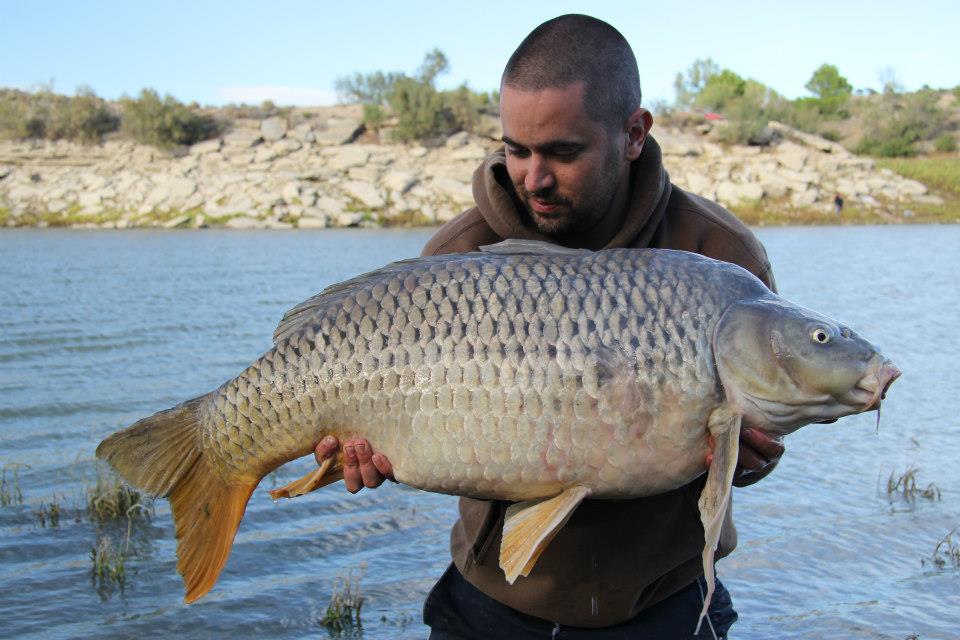
- 40lb 8oz 'rasta' carp caught on a single pellet.
Back on the Thames I tend to adopt a boilie only approach, once I have decided on a swim I will usually pre bait it for a period of time before my planned session with boilies in a mixture of shapes and sizes. This pre baiting technique can definitely pay dividends on any river, not just the Thames. It gives the fish time to gain confidence in feeding on your bait, and by using a variety of shapes and sizes of bait it gives you the option to chop and change your hook bait.
When it comes to rigs there is no need to over complicate things as river carp tend not to face the constant angler pressure that still water fish do and therefore tend not to be as rig wise. I did originally use the same rig for most of my big carp river fishing which was a simple KD bottom bait rig, comprising of a large size 4 fox armour point curve shank hook on about 6 inches of Atomic jelly wire hook link, fished in conjunction with a large 4-5oz lead.
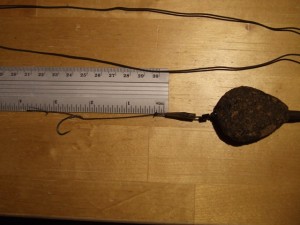
- My revised thames rig
But as always it pays to be flexible and my Thames rig has now changed, the hooking pattern has remand the same but I have cut the rig length down to 2 and half- 3 inches max fished in conjunction with 5oz drop off inline lead. I made these changes after fishing a margin swim where I was able to get up high over the spot and watch the fish feeding. On one occasion I watched the fish picking up and dropping the hook bait without getting hooked. This was because they were picking up and dropping the rig without moving off and extending it; they would then carry on feeding totally oblivious. I’m sure if I had left the rig unchanged I would have caught fish but why leave something if you know it is not perfect.
So I shortened the rig right down and recast it with instant effect from then on (on this session) every fish that picked it up was hooked instantly, and with the drop off inline falling away the fish have no weight to help them shake away the hook resulting in every fish hitting the back of the net. A devastatingly effective rig but one that would probably be far less effective when fishing for rig shy still water fish. It is also important to use lead core or, if you prefer, rig tubing when fishing rivers; this is due to the amount of debris and ever present muscle beds that will slice right through your line.
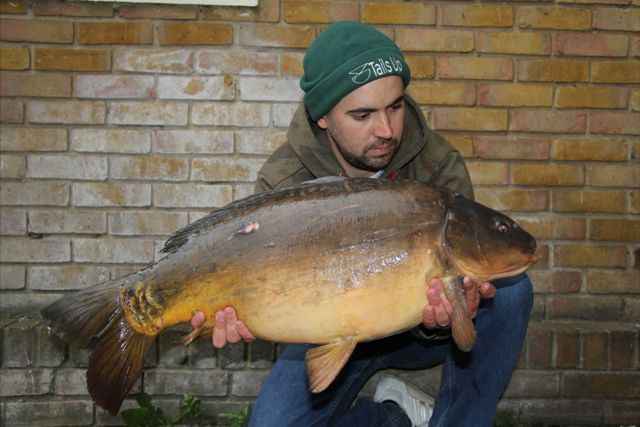
- Caught after making the change to my Thames rig.
That’s it for part one, I hope it has been helpful and next time I will discuss problems that will almost certainly occur when river carping as well as the effects of lunar activity on catch rates. Bye for now.
Rob
rob_inns@hotmail.com
rob_inns@hotmail.com
For over 64 technical carping how-to videos follow the link - French Carp Fishing

No comments:
Post a Comment